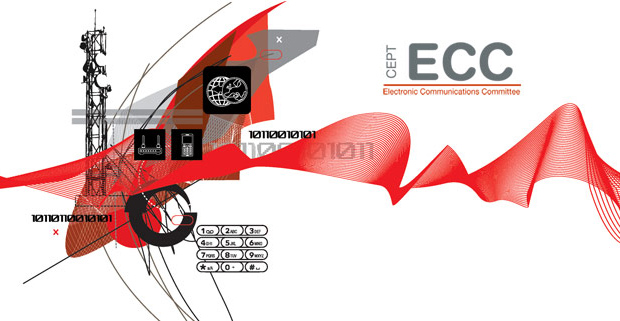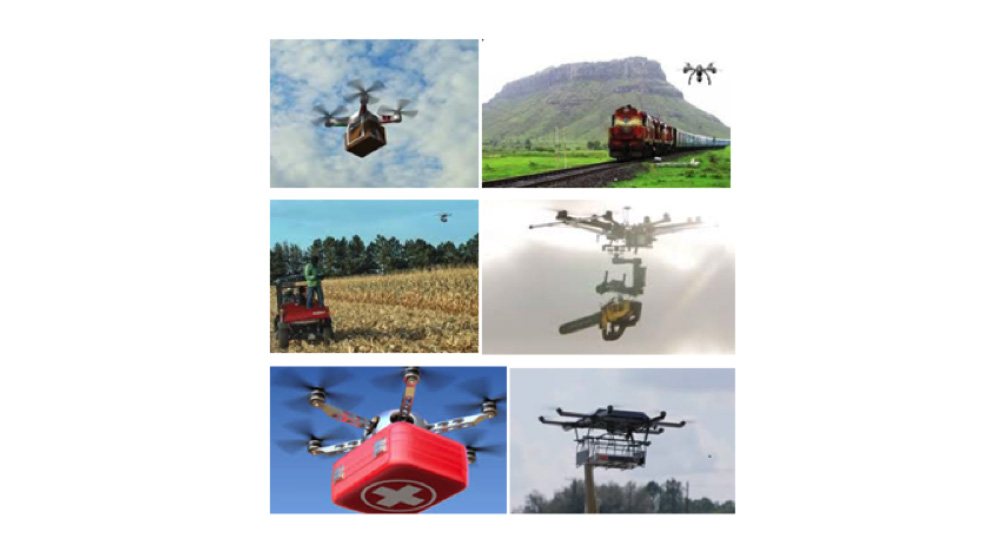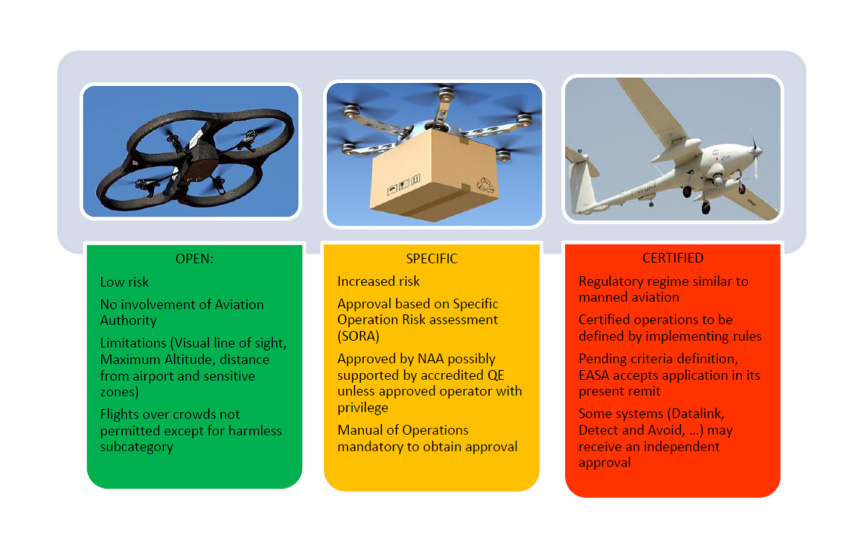ECC Newsletter August 2018
Drones and Frequencies to Fly on
As the drone industry takes off, frequency regulators and stakeholders are examining spectrum’s role in realising its potential
The use of drones/unmanned aircraft systems (UAS) has grown hugely in recent years. Various analysts such as Gartner1 expect the drone market to exceed €10bn by 2020. They say that around 3 million drone units were manufactured in 2017. As UAS technology has undergone significant development, the market for both civil and commercial drones has grown.
There are a number of challenges in fully realising the potential for growth that UAS bring with them. One of these challenges is meeting the spectrum requirements for UAS.
Spectrum for drones/UAS
When it comes to UAS, frequencies are used in a number of ways: for command and control (CC) and identification, as well as for payload transmissions (e.g. on-board cameras sending information to the ground). Communications solutions are also needed for drones-to-drones, drones-to-infrastructure and for radar sensors and optical sensors on board the drones. In addition, they are needed for distribution of positioning information in order to avoid collisions, geo-awareness about fly zone restrictions such as around airports, sensitive facilities and locations, and drones traffic management.
CEPT Workshop on Spectrum for Drones/UAS
With this in mind, CEPT held a Workshop on ‘spectrum for drones – UAS’ in sunny Copenhagen on 29-30 May 2018. The focus of the workshop was on drones which fly in circumstances where they do not need communications with air traffic control.

The two-day event brought together around 100 stakeholders from CEPT administrations, European organisations and associations, industry and the aviation sector to discuss the future requirements around UAS and spectrum. It was a packed schedule, with around 25 speakers delivering informative presentations across the two days, often leading to robust discussions.
The workshop heard how drones are already being used for civil and commercial use, by everyone from flying model enthusiasts to those within agriculture or the government (e.g. public protection and disaster relief). In some jurisdictions drones have already become vital tools in disaster situations. They are sent up to the sky to inspect fires, flooding damage or to drop buoys into the sea to rescue swimmers, for example. Other possible governmental applications include intervention and enforcement actions (e.g. jamming or ‘catching’ a drone or the remote control); it is clear that such actions must not harm any people.
Regulatory framework for Drones/UAS
The workshop heard from the European Aviation Safety Agency (EASA), which has new draft regulations before the EU Commission. The approach includes three categories of operations (Open, Specific and Certified) in an operation centric approach.
Frequencies for the certified category were outside of the focus of the CEPT Workshop. They are expected in bands allocated to the aeronautical mobile service.
In recent years, the need for traffic management applicable to UAS emerged in many parts of the world. This UAS traffic management system (UTM) would ensure safe operation of a large number of drones at low-altitude (especially in urban areas). As traditional air traffic management (ATM) ensures the safety of aircraft operations at high altitude, so does UTM at a lower altitude. The development of a UTM concept for Europe is called U-Space. It consists of a set of services enabling complex drone operations in all types of operational environments. The precise coexistence with ATM may need some specifications about reference points, the definition of air spaces (relationship of ATM and the U-Space), ensuring the safe coexistence of helicopters and UAS at low heights above ground, and even high altitude drones using the U-Space during take-off and landing. Some low altitude drones may need an interface with ATM in the future. Many initiatives are currently discussing this possibility.
The draft delegated act, as part of the new proposed European regulations, is limited to the open category and will define applicable technical conditions. An operation is classified in the open category as long as it complies with the relevant constraints; if not it must be classified in the specific category. There are limits around the height drones can fly (120m) and the weight they can carry (25kg) in the open category, in which beyond visual line of sight operations are clearly excluded.
In the specific category, the basic principle is that a UAS operation, before being conducted, must be approved on the basis of a risk assessment. It contains, among other requirements, electronic identification and geo-awareness, which are considered steps in the right direction for U-Space. However, the regulations will need to be complemented later on to take U-Space into account. The delegated act will be complemented by an implementing act defining operational conditions as part of the new European regulatory approach.
These acts are expected to be published by the end of 2018 or in early 2019. They will be complemented by related standardisation initiatives. By 2021, all new drones must have the CE mark, according to the new European regulations. Radio transmitters on board drones of the open and specific categories will have to comply with requirements set out in the Radio Equipment Directive 2014/53/EU. The regulation will give EU Member States some flexibility in what exactly they adopt. National authorities can have specific exceptions on a national level.
The presentations, photos and summary of the workshop are available here.
Work in the ECC on Spectrum for Drones/UAS
In February 2018, the ECC published ECC Report 268 on the technical and regulatory aspects and the needs for spectrum regulation when it comes to drones. Following that report and discussions at the workshop, it was found that the focus on drones in both open and specific categories seemed appropriate.
In addition, an explanatory document was approved by the WG FM of the ECC. Non-professional UAS usage should make use of frequency opportunities under general authorisations, in other words without any individual rights. The most common use is found in the 2400-2483.5 MHz and 5725-5875 MHz bands under the current regulatory conditions set out in ERC Recommendation 70-03.
Other usage opportunities exist in the 433 MHz and 863-870 MHz ranges. Such opportunities are based on harmonised frequency use without restrictions (RE Directive Class 1 equipment), and use is only bound to the technical and operational conditions provided in the ERC Recommendation 70-03 and the EC Decision for SRD (2006/771/EC as amended). There are also other frequency opportunities under general authorisation schemes such as for non-specific SRD or specific ones. For example ERC Recommendation 70-03 Annex 8 includes model control in the 27 MHz, 35 MHz and 40 MHz frequency ranges. Flying models do not normally use any kind of infrastructure. Market surveillance actions on imported equipment operating in frequency bands under general authorisations were also highlighted at the workshop as an important issue.
Various use cases, different spectrum needs
Usage opportunities under general authorisations are not appropriate for all drone users as the emission limits are often too low, restricting the range of operation, and there is a risk of interference from other users in such frequency bands and ultimately of insecure investments. The workshop discussed some ideas for frequency bands which could be considered to provide more reliable spectrum access and to support longer range and highly reliable CC for UAS ̶ for both professional and governmental drone applications. In such professional or governmental use cases, individual authorisation or the equivalent is foreseen. ETSI will support this work and is preparing a new technical report describing professional UAS use cases. Professional applications may even include UAS ‘swarm’ or ‘fleet’ applications. Highly professional applications may use the aviation infrastructure used for communication, navigation, surveillance, such as VHF, GPS and automatic dependant surveillance. Intelligent Transport System technologies such as IEEE 802.11/11p/ITS G5 as well as LTE V2X) may provide solutions. Specific solutions may use e.g. PMR, PMSE, C-band, or even higher bands (PMP solutions).
The CEPT workshop heard that harmonisation of the spectrum would foster a common market and cross-border co-operation. It would also be needed for the technical solutions required under the new drones/UAS regulatory framework such as for identification and geo-awareness, and perhaps more, once the U-Space is increasingly specified.
It was agreed at the workshop that, in the future, spectrum harmonisation may indeed be needed in areas of e-identification, geo-awareness and anti-collision. The various ideas for the technical solutions have, however, not converged in standardisation, while the use of several technologies may even provide a potentially safer approach using data fusion. Hence, the precise impact and needs for new frequency opportunities for drones/UAS is not yet clear. It is expected that ECC’s WG FM will further investigate this and that a new work item will be adopted at the next WG FM meeting in September 2018.
Another solution is ‘to fly’ professional drones/UAS using existing cellular mobile networks. This can be realised either by an external LTE device attached to UAS or in future by implementing SIM-cards installed within UAS. ECC Project Team 1 has adopted a work item for a new ECC Report to discuss all aspects of relevance for use of Mobile Fixed Communications Networks (MFCN) for UAS, including the impact on networks and other operators and the ability to achieve reliable coverage, handover, roaming, and connection to many base stations.
At the workshop, there was strong interest from some industry representatives for covering payload, CC and U-Space to the extent possible through cellular networks. In the standardisation field, 3GPP is also working on a Release-15 (LTE) study item towards a technical report, while bands below 3.8 GHz are of interest, in support of UAS network services. Solutions to be addressed are not only infrastructure-based; the PC5 mode could potentially also be used for UAS in future.
For payload use of drones/UAS, this could be provided in the video PMSE bands as identified in ERC Recommendation 25-10, noting that videos from cameras is the most important payload usage of drones/ UAS. However, there could be some capacity constraints and issues about real-time solutions without too much latency use. The workshop also heard about numerous new UAS applications, all pushing for very high payload throughput.
This will be investigated further within ECC WG FM.
Further aspects for consideration
The question of needing new spectrum compatibility studies was raised at the workshop. Many spectrum compatibility and sharing studies in the past did not consider the use case ‘UAS/drone’ but rather only usage on the ground or at limited height. UAS/drones by nature can interfere and can be interfered with much easier due to their exposed location in the sky providing line-of-sight to other systems. Existing studies will be checked, as appropriate, to see if some additional studies are needed during the future investigations in ECC.
It will be up to civil aviation to define how to provide drones/UAS functionalities and their relation to U-Space in the future. Resulting possible spectrum requirements will be discussed in the ECC. This will require that the ECC will closely work together with relevant organisations and partners, which include EASA, ETSI and Eurocontrol, during the ongoing process.
Thomas Weber, Spectrum Expert, European Communications Office
1 Gartner Inc. "Forecast: Personal and Commercial Drones, Worldwide, 2016."






